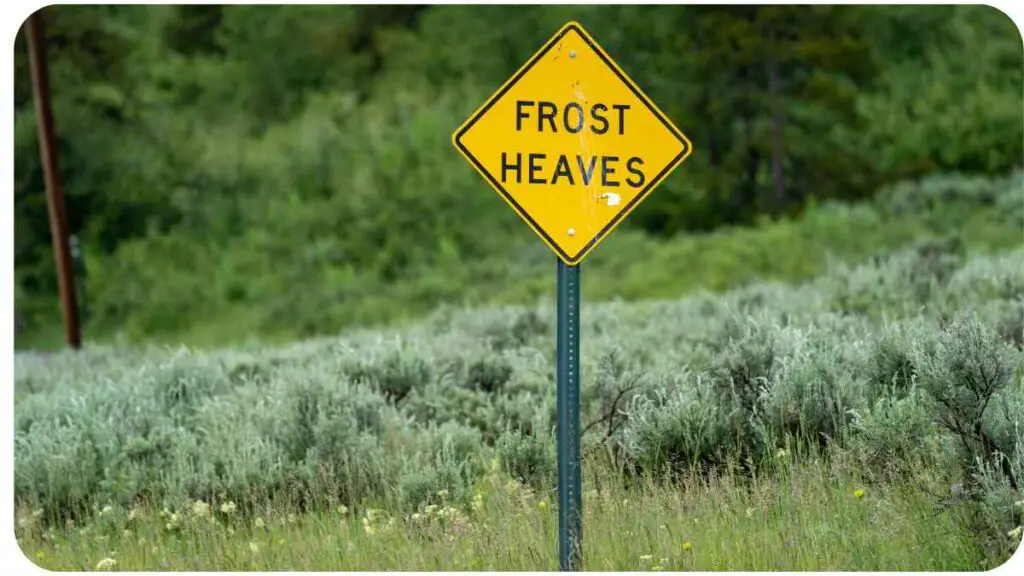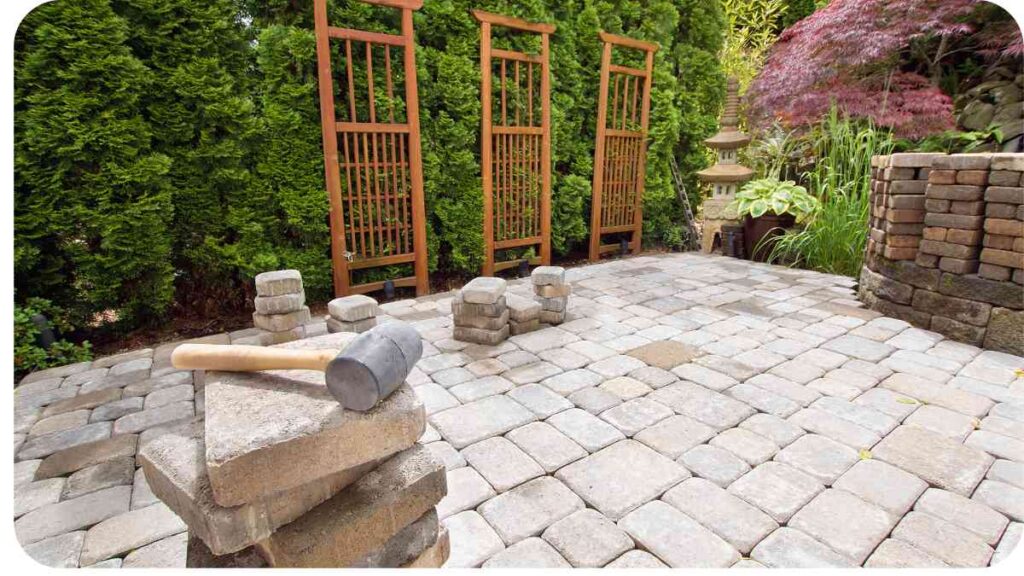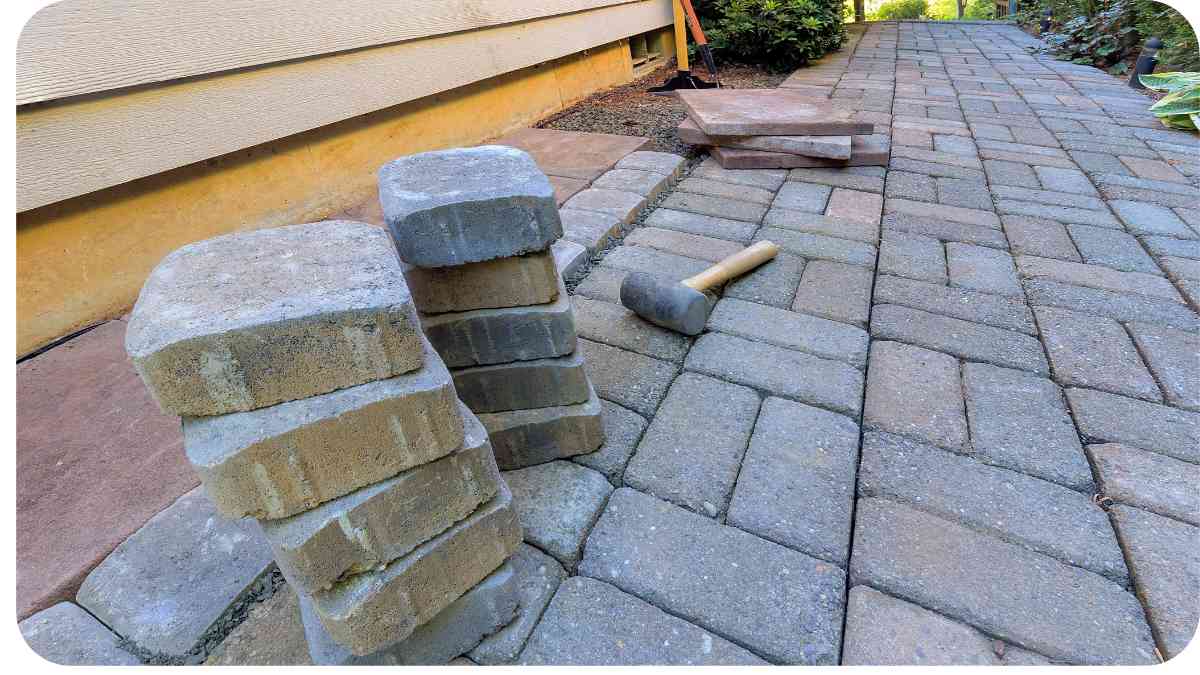Welcome to our guide on addressing hardscape heaving issues with your patio pavers. As a seasoned professional in the hardscaping industry, I understand the frustration that comes with watching your beautiful patio pavers shift, sink, or heave over time.
In this comprehensive article, I’ll draw from my expertise to help you understand the causes of hardscape heaving, how to prevent it, and what steps to take if it’s already affecting your pavers.
Key Takeaways
- Understand the causes of hardscape heaving, including freeze-thaw cycles and poor drainage.
- Recognize signs of hardscape heaving, such as uneven pavers and gaps.
- Prevent heaving through proper base preparation, material selection, and installation techniques.
- Address heaving issues promptly by repairing, releveling, or replacing damaged pavers.
- Perform seasonal maintenance, including winter snow removal and summer cleaning.
- Ensure long-lasting hardscapes with proper drainage, regular inspections, and professional help when needed.
- Choose the right contractor for your hardscaping project based on research and references.
- Frequently inspect your patio pavers for signs of damage or shifting.
- Consider eco-friendly options like permeable pavers for environmentally conscious hardscaping.
- Prioritize the longevity of your hardscape to enjoy it for years to come.
Understanding Hardscape Heaving
2.1 What Causes Hardscape Heaving?
Hardscape heaving occurs when the ground underneath your patio pavers expands and contracts due to various factors. These factors include:
When planning your outdoor space, it’s crucial to understand the fundamentals of hardscaping. Discover the key aspects of hardscape design to create a lasting and beautiful landscape.
Table 2.1.1: Common Causes of Hardscape Heaving
| Cause | Description |
| Freeze-Thaw Cycles | Freezing temperatures cause the ground to expand, pushing pavers upward when it thaws. |
| Poor Drainage | Water accumulation beneath pavers can lead to soil erosion and uneven settling. |
| Improper Base | Insufficient or poorly compacted base materials can result in paver displacement. |
| Tree Roots | Growing tree roots can exert pressure on pavers, causing them to lift. |
2.2 Signs of Hardscape Heaving

To address hardscape heaving effectively, you need to recognize its signs early. Keep an eye out for the following:
Table 2.2.1: Signs of Hardscape Heaving
| Sign | Description |
| Uneven Pavers | Pavers are no longer level, causing a tripping hazard. |
| Gaps Between Pavers | Spaces forming between pavers due to shifting and upheaval. |
| Cracked or Broken Pavers | Pavers may crack or break when subjected to heaving pressures. |
| Pooling Water | Water collects on the surface, indicating poor drainage. |
Now that you understand the causes and signs of hardscape heaving, let’s explore how to prevent this issue in the first place.
Are you considering patio pavers? Learn ’10 Surprising Hardscaping Tips’ to make your project a success. Find expert advice on hardscape installation for stunning results.
Preventing Hardscape Heaving
3.1 Proper Base Preparation
The foundation of a sturdy patio begins with the base. To prevent hardscape heaving, follow these guidelines when preparing the base:
Table 3.1.1: Steps for Proper Base Preparation
| Step | Description |
| Excavation | Dig to the appropriate depth, ensuring uniformity across the entire area. |
| Compaction | Compact the soil thoroughly to prevent settling after installation. |
| Geotextile Fabric Installation | Lay geotextile fabric to deter weed growth and provide stability. |
3.2 Choosing the Right Materials
Selecting the right materials is crucial in preventing hardscape heaving. Here are some considerations:
Table 3.2.1: Materials for Hardscape Construction
| Material | Description |
| Interlocking Pavers | These are designed to interlock, reducing the chance of heaving. |
| Porous Paver Systems | Allow water to drain through, reducing the risk of water buildup. |
| Quality Base Materials | Choose high-quality gravel and sand for a stable foundation. |
3.3 Installation Techniques
Proper installation techniques play a significant role in preventing hardscape heaving. Follow these tips:
To avoid common hardscaping mistakes, it’s essential to follow ‘The Dos and Don’ts of Hardscaping.’ This guide provides valuable insights into creating a durable and appealing hardscape design.
Table 3.3.1: Hardscape Installation Tips
| Tip | Description |
| Edge Restraints | Use edge restraints to prevent pavers from shifting outward. |
| Polymeric Sand | Fill joints with polymeric sand to inhibit weed growth and movement. |
| Professional Installation | Consider hiring professionals for precise and stable installations. |
Addressing Hardscape Heaving

4.1 Repairing Sunken Pavers
If you notice sunken pavers on your patio, it’s essential to address the issue promptly. Here’s how:
Table 4.1.1: Steps to Repair Sunken Pavers
| Step | Description |
| Remove Sunken Pavers | Carefully lift and remove sunken pavers from the affected area. |
| Adjust Base | Add or compact base materials as needed to level the area. |
| Reinstall Pavers | Place pavers back in position, ensuring they’re level. |
4.2 Releveling Uneven Pavers
Uneven pavers are not only unsightly but also pose a tripping hazard. Here’s how to relevel them:
Transform your outdoor space with a hardscaped oasis. Explore ‘How to Create the Perfect Hardscaped Outdoor Space’ for tips on design, materials, and hardscape construction.
Table 4.2.1: Steps to Relevel Uneven Pavers
| Step | Description |
| Identify High Spots | Determine which pavers are higher and causing the unevenness. |
| Remove High Pavers | Carefully remove and adjust the base or add sand as necessary. |
| Reinstall Pavers | Reinstall the pavers, ensuring they’re level with adjacent ones. |
4.3 Replacing Damaged Pavers
Sometimes, pavers get damaged beyond repair. Here’s how to replace them:
Table 4.3.1: Steps to Replace Damaged Pavers
| Step | Description |
| Remove Damaged Pavers | Gently pry out and remove the damaged pavers from the area. |
| Prepare the Space | Clean the space and adjust the base if necessary. |
| Install New Pavers | Place new pavers in the vacated spaces, ensuring they fit. |
By addressing these issues promptly, you can maintain the aesthetics and safety of your patio.
Seasonal Maintenance
5.1 Winter Maintenance
Winter can be particularly harsh on patio pavers. To ensure they withstand the cold months, consider the following steps:
Stay ahead of the curve in outdoor design with ‘The Top Trends in Hardscaping for 2023.’ Discover the latest innovations and styles in the world of hardscape landscaping to elevate your outdoor living experience.
Table 5.1.1: Winter Maintenance Tips
| Tip | Description |
| Snow Removal | Clear snow promptly to prevent moisture seepage and freezing. |
| De-Icing Precautions | Use ice melt products sparingly to avoid damage to pavers. |
| Inspect for Damage | After winter, check for any damage or heaving and address it. |
5.2 Summer Maintenance
Summer maintenance is equally important to keep your patio in excellent condition. Here’s what you should do:
Table 5.2.1: Summer Maintenance Tips
| Tip | Description |
| Weed Control | Regularly remove weeds from joints to prevent paver shifting. |
| Sealant Application | Apply sealant to protect pavers from UV rays and stains. |
| Cleanliness | Keep the patio clean from debris and spills to prevent stains. |
Expert Tips for Long-lasting Hardscapes
6.1 Proper Drainage Solutions
Ensuring proper drainage is essential to prevent hardscape heaving. Consider these drainage solutions:
Table 6.1.1: Drainage Solutions
| Solution | Description |
| French Drains | Install French drains to direct water away from the patio area. |
| Grading Adjustment | Adjust the grading to promote water runoff from the pavers. |
| Permeable Paver Systems | Use permeable pavers to allow water to drain through. |
6.2 Regular Inspections
Frequent inspections can help you catch issues early. Here’s what to look for:
Table 6.2.1: Inspection Checklist
| Item | Description |
| Paver Alignment | Check if pavers are still level and properly aligned. |
| Drainage Performance | Ensure water drains away from the patio without pooling. |
| Weed Growth | Remove any weeds or vegetation growing between pavers. |
6.3 Professional Help
When in doubt or if problems persist, don’t hesitate to seek professional assistance:
Table 6.3.1: When to Call a Professional
| Situation | Description |
| Severe Damage | If the damage is extensive or recurring, consult an expert. |
| Complex Repairs | For intricate repairs or large-scale projects, hire a pro. |
| Design and Installation | Professionals can ensure proper design and installation. |
Personal Experiences: Dealing with Hardscape Heaving
7.1 Case Study: The Smiths’ Patio Paver Nightmare
In my years of working in the hardscaping industry, I’ve encountered numerous situations like the Smiths’. Their patio pavers had suffered severe heaving due to poor drainage and an improper base. By following the steps outlined in this article, we were able to rescue their patio from disrepair and ensure it would stand the test of time.
When addressing hardscape heaving, remember that professional guidance can make all the difference.
Choosing the Right Contractor
When embarking on a hardscaping project, one of the most critical decisions you’ll make is choosing the right contractor. Here’s how to ensure you pick the best one for your project:
Table 8.1: Tips for Selecting the Right Contractor
| Tip | Description |
| Research and References | Conduct thorough research and ask for references from past clients. |
| Licensing and Insurance | Verify that the contractor is licensed and adequately insured. |
| Written Agreements | Always have a written contract outlining project details. |
| Warranty and Guarantees | Understand the warranty and guarantees offered for the work. |
| Communication and Experience | Choose a contractor with excellent communication skills and experience. |
Frequently Asked Questions
As we near the end of this guide, let’s address some common questions readers may have:
Table 9.1: Frequently Asked Questions
| Question | Answer |
| Q1: Can hardscape heaving be prevented entirely? | While it can’t be prevented entirely, proper steps can minimize it. |
| Q2: How often should I inspect my patio pavers? | Regular inspections at least once a season are recommended. |
| Q3: Is DIY repair possible, or should I hire a professional? | It depends on the extent of the damage; consult a pro when in doubt. |
| Q4: Are there environmentally friendly paver options? | Yes, permeable pavers are eco-friendly and help with drainage. |
Conclusion
In conclusion, addressing hardscape heaving is crucial for maintaining the beauty and safety of your patio pavers. By understanding the causes, signs, and prevention measures, you can ensure your hardscape remains in top condition.
Remember that proper base preparation, material selection, and installation techniques are the first line of defense. Regular maintenance, both in winter and summer, is essential to prolong the lifespan of your patio.
Drawing from my own experiences in the industry, I’ve shared valuable insights and tips to guide you through the process. Whether it’s repairing sunken pavers or choosing the right contractor, following these recommendations will help you tackle hardscape heaving with confidence.
Don’t forget to consult professionals when needed, and always prioritize the long-term health of your hardscape. With the right knowledge and actions, you can enjoy your beautiful patio for years to come.

Hi! My name is Hellen James, and I’m a landscape designer in Los Angeles. I’ve been working with homeowners and businesses to help them improve the look of their properties for over 10 years.


